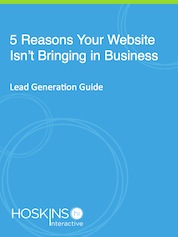Hoskins Interactive Media & Marketing Blog
Current Articles Rss FeedThree Small Business Quick Wins That Increase Website Traffic
Posted bywpbizMon, May 6, 2013 @ 12:29 pm
There’s just a lot going on. Maybe your website needs a design refresh, or the copy doesn’t adequetely describe your company now. But you don’t want to halt all momentum by taking months to rethink branding or reposition corporate identity.
We understand. Most small businesses we work with are juggling long-term projects with shorter, quick wins that allow them to balance the process of achieving a professional online image with lead generation.
So while the rest of your site may be literally or figuratively under construction, there are three things you can do to keep the engine moving:
Blogging
The act of publishing content and message relevancy are two reasons why blogging is so effective in stimulating traffic. The more you publish blogs, the more you grab the attention of search engines and make your content accessible to people searching for information.
People are generally online for two reasons: to be entertained and/or to find information that solves a problem. This puts you in a powerful position to provide answers, so what do you have to say? Publishing messages that your audiences appreciates encourages repeat visits, subscriptions and website exploration.
What matters most: quality and frequency.
Make sure your posts answer customers’ questions or provide helpful insights. This is a way to introduce you, your company, your culture, your services and what’s in it for the customer. People do business with people they like, so the blog is a wonderful place to educate, advise and hook the fish, so to speak.
But you have to blog regularly. Search engines reward that kind of dependable behavior, so start by publishing a blog once a week and work your way up to two, three, four times—even five. Your traffic will generally spike each time you publish a blog, so it’s ideal to publish often and regularly.
Search Engine Optimization (SEO)
Blogs need two major things to be identified by search engines: a keyword-rich title and a meta description that elaborates. Both help increase organic traffic, the free traffic you generate by producing content relevant to users’ searches.
Keywords are assigned ratings to indicate how often the phrase is searched and how difficult it is to be ranked for the phrase. This just means that you have to be smart and selective about the keywords you use and how you use them. “Shoulder exercises” isn’t as specific as “exercises for scapular instability;” this phrase might not attract your target audience. Shoot for three or four word phrases, long-tail keywords, to describe your blog topic.
Search engines assess the title and meta description attached to your blog; the meta description is a field your website content management system should prompt you to fill in. Typically 150 characters, the meta description is one sentence that describes what the blog or website page is about. Use your long-tail keyword here—it reinforces the phrase and indicates quality. When marketers talk about optimization, this is what they’re referring to: consistent and specific use of keywords to identify content for search engines.
What matters most: using a competitive long-tail keyword in title and meta description. Don’t blog without them.
Social Media Promotion
Your blog may just sit there unnoticed until you put some muscle behind it. Promoting your blog on multiple social media sites is the best way to encourage people to visit your blog.
Ultimately, you want to build audiences on the major social sites: LinkedIn, Twitter, Facebook and Google+. But don’t rule out smaller, niche sites where your industry frequents. You want to go where your prospects are heavily concentrated, but in the beginning you may be more connected elsewhere. Focus where you are most active first and make a plan to get involved on sites where the big fish are.
We experienced this: LinkedIn is an incredible site for business connections, but our best leads came from Facebook friends—people who knew us personally, outside of a business context. It’s true, people do business with people they like. Those relationships, no matter how they developed, will serve you.
Hopefully your company is active on a few social sites. Pay attention to the audience that visits and draft a sentence teaser that will be well received for each site. This takes a little insight into each platform’s personality. “10 ways to increase website traffic” may work well on LinkedIn or Twitter, but “Trying to reach prospective customers? We’ve seen these 10 strategies work” might be more effective for Facebook; it’s a bit more personal. Targeting your message for each social platform is a little time consuming, but your audience will appreciate various perspectives on your services—especially if they follow your company on more than one social platform.
Use an image. It looks professional, and people respond to images and other formatting that break up the text. Make it easy for visitors to grasp the gist of the article at a glance: use bullets, bolding white space and an attractive image.
The image will appear as a thumbnail when you post your blog teaser on each social media site. It could compel prospects to click the link and read the full story.
 What matters most: start promoting where you’re most social, target your teaser, image. What matters most: start promoting where you’re most social, target your teaser, image.
How do you turn new visitors into customers? Find out. Download HI’s free Lead Generation Guide.
photo credit: AdventuresInAnalog viaphotopin cc |
